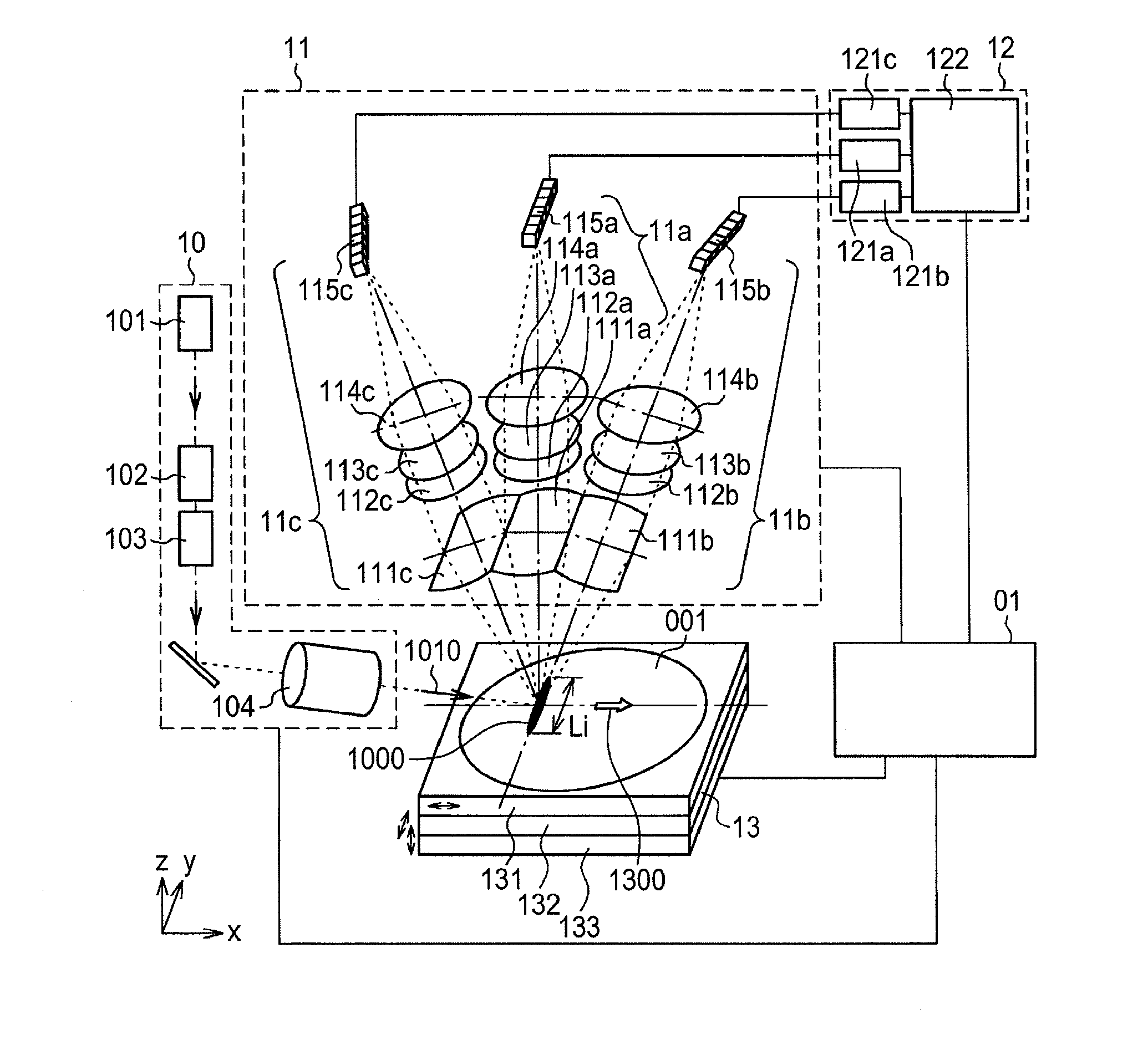Defect inspection method and defect inspection device
a defect detection and defect technology, applied in semiconductor/solid-state device testing/measurement, instruments, material analysis, etc., can solve the problems of defect detection sensitivity decreasing and detection sensitivity difficult to improve, and achieve high-sensitivity inspection
- Summary
- Abstract
- Description
- Claims
- Application Information
AI Technical Summary
Benefits of technology
Problems solved by technology
Method used
Image
Examples
first embodiment
[0056]FIG. 1 shows an example of a defect inspection device configuration as a first embodiment. The defect inspection device according to the present embodiment includes an illumination optics unit 10, a detection optics unit 11, a data-processing unit 12, a stage unit 13, and a total control unit 01.
[0057]The illumination optics unit 10 includes a light source 101, a polarization state controller 102, a beam-forming unit 103, and a thin-line converging optics system 104. Illumination light that has emitted from the light source 101 in this configuration is passed through the polarization state controller 102 and the beam-forming unit 103, and then introduced into the thin-line converging optics system 104. The polarization state controller 102 is a member including such polarizers as a half-wave plate and a quarter-wave plate. The polarization state controller 102, further fitted with a driving element (not shown) that is adapted to rotate about an optical axis of the illumination...
second embodiment
[0107]Changes in ambient environment significantly affect the image quality of the scattered light. Although changes in temperature can be accommodated by merely providing a temperature control mechanism inside the device, it is difficult in terms of costs to provide, against changes in atmospheric pressure, a structure or mechanism that keeps an internal atmospheric pressure of the entire device constant.
[0108]FIGS. 9A and 9B are diagrams that explain impacts of atmospheric pressure changes upon the deterioration of image quality. FIG. 9A shows calculation results that indicate how changes in atmospheric pressure vary lens aberration. For example, even if a lens is assembled and adjusted under an environment of 1,000 hPa and aberration is controlled below 0.1λ, a decrease of the atmospheric pressure to 850 hPa degrades aberration to 0.2λ.
[0109]The degradation in aberration is a component that cannot be sufficiently corrected by adjustment of the imaging position, as in the prior-ar...
third embodiment
[0134]A third embodiment relates to a direction of illumination. As described earlier herein, the present embodiment presupposes that the longitudinal direction of the thin linear illumination region 1000 is set to be the y-axis direction, but this is not intended to limit the direction of the illumination.
[0135]Constituent elements of the present embodiment, such as the illumination optics unit 10 and the detection optics system 11, are substantially the same as in the defect inspection device of the first embodiment described using FIG. 1, and the present (third) embodiment differs from the first embodiment in terms of a location of the illumination optics unit 10 relative to the detection optics system 11.
[0136]As shown in FIG. 11, a plane 1010, formed by a line 1111 normal to a surface of a wafer 001 and an optical axis of the illumination light, may have an arbitrary azimuth angle “φi” with respect to the y-axis. Thus, as described earlier herein, different scattered-light comp...
PUM
 Login to View More
Login to View More Abstract
Description
Claims
Application Information
 Login to View More
Login to View More - R&D
- Intellectual Property
- Life Sciences
- Materials
- Tech Scout
- Unparalleled Data Quality
- Higher Quality Content
- 60% Fewer Hallucinations
Browse by: Latest US Patents, China's latest patents, Technical Efficacy Thesaurus, Application Domain, Technology Topic, Popular Technical Reports.
© 2025 PatSnap. All rights reserved.Legal|Privacy policy|Modern Slavery Act Transparency Statement|Sitemap|About US| Contact US: help@patsnap.com



